Activated platelets contribute to stimulation of cardiac afferents during ischaemia in cats: role of 5-HT(3) receptors
- PMID: 12411532
- PMCID: PMC2290632
- DOI: 10.1113/jphysiol.2002.023374
Activated platelets contribute to stimulation of cardiac afferents during ischaemia in cats: role of 5-HT(3) receptors
Abstract
Myocardial ischaemia activates blood platelets and cardiac sympathetic afferents, which mediate chest pain and cardiovascular reflex responses. We have demonstrated that activated platelets stimulate ischaemically sensitive cardiac sympathetic afferents. Platelets absorb and release 5-hydroxytryptamine (5-HT) when they are activated. In the present study we hypothesized that, by releasing 5-HT, activated platelets stimulate cardiac afferents during ischaemia through a 5-HT(3) receptor mechanism. Platelet-rich plasma (PRP) and platelet-poor plasma (PPP) were obtained from cats. Activation of platelets in PRP was induced by thrombin (5 units ml(-1)) or collagen (2 mg kg(-1)). Using high-performance liquid chromatography, we observed that the concentration of 5-HT was increased significantly in suspensions of platelets activated with thrombin (PRP+thrombin, 28 +/- 1.7 microM) or collagen (PRP+collagen, 27 +/- 2.5 microM) compared with suspensions of unactivated platelets (PRP+saline, 2.3 +/- 0.8 microM) and PPP. During myocardial ischaemia and reperfusion, tirofiban, a specific inhibitor of platelet glycoprotein (GP) IIb-IIIa receptors (100 microg kg(-1), I.V., followed by 5 microg kg(-1) min(-1)), significantly reduced the increase in the concentration of 5-HT in cardiac venous plasma from ischaemic region. Nerve activity of single-unit cardiac afferents was recorded from the left sympathetic chain (T2-T5) in anaesthetized cats. Eighty ischaemically sensitive and seven ischaemically insensitive cardiac afferents were identified. Tirofiban reduced the ischaemia-related increase in activity of seven cardiac sympathetic afferents by 50 %. Injection of 1.5 ml of PRP+collagen or PRP+thrombin into the left atrium (LA) increased activity of 16 cardiac afferents. Tropisetron (300 microg kg(-1), I.V.), a selective 5-HT(3) receptor antagonist, eliminated the afferent's responses to platelets activated with collagen or thrombin. Moreover, LA injection of 5-HT (20-40 microg kg(-1)) and PBG (100 microg kg(-1)), a 5-HT(3) receptor agonist, stimulated nine ischaemically sensitive cardiac sympathetic afferents, significantly increasing the activity of these afferents. However, injection of alpha-M-5-HT (100 microg kg(-1), LA), a 5-HT(2) receptor agonist, stimulated only two of the nine ischaemically sensitive cardiac afferents, and thus did not significantly alter impulse activity of this group of afferents. Both the 5-HT(1) (5-CT, 100 microg kg(-1), LA) and 5-HT(4) receptor agonists (SC53116, 100 microg kg(-1), LA) did not stimulate any of the nine afferents tested. Tropisetron (300 microg kg(-1), I.V.) also eliminated the response of seven ischaemically sensitive cardiac afferents to exogenous 5-HT and attenuated the ischaemia-related increase in activity of nine cardiac sympathetic afferents by 41 %. Conversely, LA injection of 5-HT (40 microg kg(-1)) did not stimulate any of seven ischaemically insensitive cardiac afferents, although this group of afferents consistently responded to bradykinin (3 microg, LA). These data indicate that during myocardial ischaemia the activated platelets stimulate cardiac sympathetic afferents, at least in part, through a 5-HT(3) receptor mechanism.
Figures
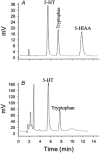
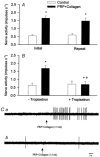
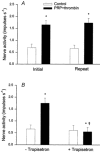

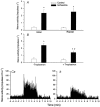


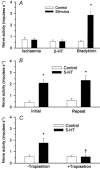

Similar articles
-
Role of 5-HT3 receptors in activation of abdominal sympathetic C fibre afferents during ischaemia in cats.J Physiol. 1998 Jun 15;509 ( Pt 3)(Pt 3):729-40. doi: 10.1111/j.1469-7793.1998.729bm.x. J Physiol. 1998. PMID: 9596795 Free PMC article.
-
Role of activated platelets in excitation of cardiac afferents during myocardial ischemia in cats.Am J Physiol Heart Circ Physiol. 2002 Jan;282(1):H100-9. doi: 10.1152/ajpheart.2002.282.1.H100. Am J Physiol Heart Circ Physiol. 2002. PMID: 11748053
-
Xanthine oxidase, but not neutrophils, contributes to activation of cardiac sympathetic afferents during myocardial ischaemia in cats.J Physiol. 2002 Aug 15;543(Pt 1):327-36. doi: 10.1113/jphysiol.2001.013482. J Physiol. 2002. PMID: 12181303 Free PMC article.
-
Cardiac sympathetic afferent activation provoked by myocardial ischemia and reperfusion. Mechanisms and reflexes.Ann N Y Acad Sci. 2001 Jun;940:74-95. doi: 10.1111/j.1749-6632.2001.tb03668.x. Ann N Y Acad Sci. 2001. PMID: 11458709 Review.
-
Reflexes mediated by cardiac sympathetic afferents during myocardial ischaemia: role of adenosine.Clin Exp Pharmacol Physiol. 1996 Aug;23(8):709-14. doi: 10.1111/j.1440-1681.1996.tb01763.x. Clin Exp Pharmacol Physiol. 1996. PMID: 8886495 Review.
Cited by
-
Functional role of peripheral opioid receptors in the regulation of cardiac spinal afferent nerve activity during myocardial ischemia.Am J Physiol Heart Circ Physiol. 2013 Jul 1;305(1):H76-85. doi: 10.1152/ajpheart.00091.2013. Epub 2013 May 3. Am J Physiol Heart Circ Physiol. 2013. PMID: 23645463 Free PMC article.
-
Disruption of the nonneuronal tph1 gene demonstrates the importance of peripheral serotonin in cardiac function.Proc Natl Acad Sci U S A. 2003 Nov 11;100(23):13525-30. doi: 10.1073/pnas.2233056100. Epub 2003 Nov 3. Proc Natl Acad Sci U S A. 2003. PMID: 14597720 Free PMC article.
-
Transporter-dependent uptake and metabolism of myocardial interstitial serotonin in the rat heart.J Physiol Sci. 2022 Oct 26;72(1):27. doi: 10.1186/s12576-022-00852-2. J Physiol Sci. 2022. PMID: 36289481 Free PMC article.
-
Tropisetron Preconditioning Decreases Myocardial Biomarkers in Patients Undergoing Heart Valve Replacement Surgery.Front Med (Lausanne). 2022 Mar 29;9:690272. doi: 10.3389/fmed.2022.690272. eCollection 2022. Front Med (Lausanne). 2022. PMID: 35425785 Free PMC article.
-
Serotonin uptake via plasma membrane monoamine transporter during myocardial ischemia-reperfusion in the rat heart in vivo.Physiol Rep. 2019 Nov;7(22):e14297. doi: 10.14814/phy2.14297. Physiol Rep. 2019. PMID: 31782271 Free PMC article.
References
-
- Abbott FV, Hong Y, Blier P. Activation of 5-HT2A receptors potentiates pain produced by inflammatory mediators. Neuropharmacology. 1996;35:99–110. - PubMed
-
- Ashton JH, Benedict CR, Fitzgerald C, Raheja S, Taylor A, Campbell WB, Buja LM, Willerson JT. Serotonin as a mediator of cyclic flow variation in stenosed canine coronoary arteries. Circulation. 1986;73:572–578. - PubMed
-
- Benedict CR, Mathew B, Rex KA, Cartwright J, Sordahl LA. Correlation of plasma serotonin changes with platelet aggregation in an in vivo dog model of spontaneous occlusive coronary thrombus formation. Circulation Research. 1986;58:58–67. - PubMed
-
- Coller BS. Platelet GPIIb/IIIa antagonists: the first anti-integrin receptor therapeutics. Journal of Clinical Investigation. 1997;100(suppl. 11):S57–60. - PubMed
Publication types
MeSH terms
Substances
Grants and funding
LinkOut - more resources
Full Text Sources
Research Materials
Miscellaneous

